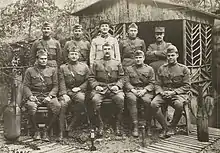Manus MacCloskey
Manus MacCloskey (April 24, 1874 – May 11, 1963) was a brigadier general in the United States Army. He served in the Philippines, participated in the China Relief Expedition, and commanded the 12th Field Artillery Regiment during World War I. After retiring from the military, he organized the Civilian Conservation Corps in North Carolina and later served as superintendent of Cook County Hospital in Chicago.
Manus MacCloskey | |
|---|---|
 McCloskey circa 1918 | |
| Born | April 24, 1874 Pittsburgh, Pennsylvania, U.S. |
| Died | May 11, 1963 (aged 89) Washington, DC, U.S. |
| Resting place | Arlington National Cemetery |
| Education | United States Military Academy (1898) |
| Spouse |
Sara Monro (m. 1901) |
| Children | 2, including Monro MacCloskey |
| Military career | |
| Rank | |
| Awards | |
Early life
He was born in Pittsburgh, Pennsylvania on April 24, 1874. MacCloskey graduated from the United States Military Academy in 1898.[1]
Military career

After his commissioning, he joined the Fifth Field Artillery on April 26, 1898.[1] In 1916, he commanded Fort Myer
He served in the Philippines and participated in the China Relief Expedition.[1]
During World War I, he organized and commanded the 12th Field Artillery Regiment. MacCloskey fought in the Battle of Verdun, the Battle of Château-Thierry (1918), the Battle of Belleau Wood, and the Battle of Soissons (1918).
From January 1921 to June 30, 1924, he served with the General staff at Headquarters, Sixth Corps Area.[1] He later served at Fort Sheridan and Fort Bragg. He retired from military service on April 30, 1938.[1]
Civilian career
In 1933, he organized the Civilian Conservation Corps (CCC) in North Carolina. He served as superintendent of Cook County Hospital in Chicago from 1938 to 1947.[1]
Awards and honors
Awards he received during his career include the Army Distinguished Service Medal, the citation for which reads:
The President of the United States of America, authorized by Act of Congress, July 9, 1918, takes pleasure in presenting the Army Distinguished Service Medal to Colonel (Field Artillery) Manus MacCloskey, United States Army, for exceptionally meritorious and distinguished services to the Government of the United States, in a duty of great responsibility during World War I. While in Command of the 12th Field Artillery during all its operations with the 2d Division, until 16 August 1918, Colonel MacCloskey displayed marked ability and efficiency. He especially distinguished himself during the operations of the 2d Division at the Bois-de-Belleau and Bouresches, when he commanded in addition to his own regiment, the 37th Field Artillery, French Army. By this service he contributed in no small measure to the success of the Infantry Brigade in these operations. Later, as Commanding General, 152d field Artillery Brigade, he rendered able support to the attacking Infantry of the 77th Division.[2]
He also received the Silver Star with oak leaf cluster, and the Purple Heart with oak leaf cluster. His Silver Star citation reads:
By direction of the President, under the provisions of the act of Congress approved July 9, 1918 (Bul. No. 43, W.D., 1918), Brigadier General Manus MacClosky, United States Army, is cited by the Commanding General, American Expeditionary Forces, for gallantry in action and a silver star may be placed upon the ribbon of the Victory Medals awarded him. Brigadier General MacClosky distinguished himself by gallantry in action while serving with the American Expeditionary Forces, in action at Vierzy, France, 19 July 1918, in making a personal reconnaissance under intense artillery and machine gun fire, in order to regulate the fire of his artillery.[2]
He also received the Order of the Crown of Italy, rank Officer for his World War I service.
Personal life and family
He married Sara Monro on August 14, 1901.[1] They had two children: Monro MacCloskey, who attained the rank of brigadier general in the United States Air Force, and Sara, who was known as Sally.[1]
Death
He died on May 11, 1963, in Washington, DC.[1][3] He is buried at Arlington National Cemetery.[4]
Legacy
In 1977, MacCloskey's personal papers were donated to the University of Pittsburgh archives by Monro MacCloskey.[5]
References
- Davis, Henry Blaine Jr. (1998). Generals in Khaki. Pentland Press, Inc. p. 251. ISBN 1571970886. OCLC 40298151.
- "Valor awards for Manus McCloskey".
- The National cyclopaedia of American biography : being the history of the United States as illustrated in the lives of the founders, builders, and defenders of the republic, and of the men and women who are doing the work and moulding the thought of the present time. University Microfilms. 1970. p. 569.
- "Manus MacCloskey, Brigadier General, United States Army". ArlingtonCemetery.net. an unofficial website.
- "Guides to Archives and Manuscript Collections at the University of Pittsburgh Library System".